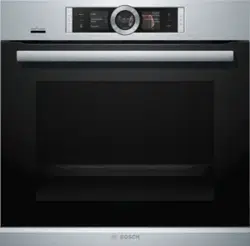Loading ...
Loading ...
Loading ...

46
Meat
Your appliance offers a range of heating methods for
preparing meat. You can find the ideal settings for many
dishes in the settings tables.
Roasting and Braising
Baste lean meat with fat as required or cover it with strips
of bacon.
Score the rind crosswise. If you turn the roast when
cooking, ensure that the rind is underneath at first.
When the roast is ready, turn off the oven and allow it to
rest for another 10minutes in the cooking compartment.
This allows the meat juices to be better distributed. Wrap
the roast in aluminum foil if necessary. The
recommended resting time is not included in the
indicated cooking time.
Roasting and Braising in Cookware
It is more convenient to roast and braise meat in
cookware. You can take the roast out of the cooking
compartment more easily in the cookware, and prepare
the sauce in the cookware itself.
Only use cookware that is suitable for use in an oven.
Check that the cookware fits in the cooking
compartment.
Glass cookware is the most suitable. Place hot glass
cookware onto a dry mat after cooking. The glass could
crack if placed on a cold or wet surface.
When roasting, add in a little liquid if the meat is lean.
Wtih glass cookware, the bottom of the cookware should
be covered with approx.
^ inch (2cm) of liquid.
The quantity of liquid is dependent on the type of meat,
the cookware material, and also on whether or not a lid is
used. When preparing meat in an enamelled or dark
metal roasting dish, it will need a little more liquid than
when cooked in glass cookware.
During roasting, the liquid in the cookware will evaporate.
Carefully pour in more liquid if required.
Shiny roasting dishes made from stainless steel or
aluminum reflect heat like a mirror and are therefore not
particularly suitable. The meat cooks more slowly and will
not brown so much. Use a higher temperature and/or a
longer cooking time.
Observe the manufacturer's instructions for your roasting
cookware.
Uncovered Cookware
It is best to use a deep roasting pan/dish for roasting
meat. Place the pan/dish onto the wire rack.
Covered Cookware
When preparing food with covered cookware, the
cooking compartment remains considerably cleaner.
Ensure that the lid fits well and closes properly. Place the
cookware onto the wire rack.
The distance between the meat and the lid should be at
least 3cm. The meat may rise.
Very hot steam may escape when opening the lid after
cooking. Lift the lid in the back, so that the hot steam can
escape away from you.
If necessary, braise the meat first by searing it. Add
water, wine, vinegar, or a similar liquid for the braising
liquid. Cover the bottom of the cookware with approx. 1–
2cm of liquid.
During roasting, the liquid in the cookware will evaporate.
Carefully pour in more liquid if required.
Meat can also become crispy in a covered roasting dish.
To do so, use a roasting dish with a glass lid and set a
higher temperature.
Broiling
Keep the appliance door closed when using the broil
mode. Never broil with the appliance door open.
When broiling, try wherever possible to use pieces of
food which are of a similar thickness and weight. This will
allow them to brown evenly and remain succulent and
juicy.
Use tongs to turn the pieces of food you are broiling. If
you pierce the meat with a fork, the juices will run out and
it will become dry.
Do not add salt until after the meat has been broiled. Salt
draws water from the meat.
Notes
▯ The grill element switches itself on and off
continuously; this is normal. The grill setting
determines how frequently this occurs.
▯ Smoke may be produced when grilling.
Recommended Setting Values
You can find the ideal heating method for many meat
dishes in the table. Temperature and cooking time
depend on the quantity, consistency, and temperature of
the food. For this reason, setting ranges are indicated.
Try using the lower values to start with. You can increase
the temperature next time if necessary.
The setting values apply to chilled meat placed into the
cold cooking compartment. If you preheat the oven, you
can reduce the indicated cooking times by several
minutes.
You can find information on roasts and default values for
weights in the table. If you wish to roast a heavy piece of
meat, you should definitely use a lower temperature. If
cooking multiple pieces, use the weight of the heaviest
piece as a reference for determining the cooking time.
The individual pieces should be approximately equal in
size.
A general rule: the larger the roast, the lower the cooking
temperature and the longer the cooking time.
Turn roasts and grilled items after approx. ^ to Z of the
indicated time.
If you wish to follow one of your own recipes, you should
use similar dishes as a reference. Additional information
can be found in the tips on roasting, braising, and grilling
listed after the settings table.
Remove unused accessories from the cooking
compartment. This will ensure that you achieve the best
possible cooking results.
Heating methods used:
▯ % Bake
▯ 7 Convection Broil
▯ ( Broil
Loading ...
Loading ...
Loading ...
